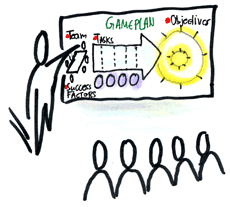Benefits
 1. Graphic facilitation balances out participation. The drawings literally call forth everybody's contribution and make as much space for the reserved personality as for the polemic point of view. 1. Graphic facilitation balances out participation. The drawings literally call forth everybody's contribution and make as much space for the reserved personality as for the polemic point of view.
2. Participative decision making generates commitment, which leads to a more enthusiastic and effective implementation of action plans.
3. The display of all points of view on the same support puts them on equal terms and enables a more objective debate. Common ground and consensus become easier to find.
4. The graphic templates clarify complex situations and keep the group focused on their desired meeting outcome.
5. Most people have a predominantly visual way of processing information. Their creative thinking and the search for more daring solutions get stimulated here.
6. The needs of both analytical / structured (left hand brain) and creative / intuitive people (right hand brain) are met. The methodology creates a place of synergy for often opposed characteristics.
7. The group's thought process and evolution gets registered and structured. Agreements become traceable and more transparent.
8. The final drawings are a powerful means of communication to the rest of the organisation (Situation analysis, strategic vision, action plans.)
9. The method is a training in itself:
10. The positive behaviours for participative decision making get trained. Other meetings also become more productive. |
































